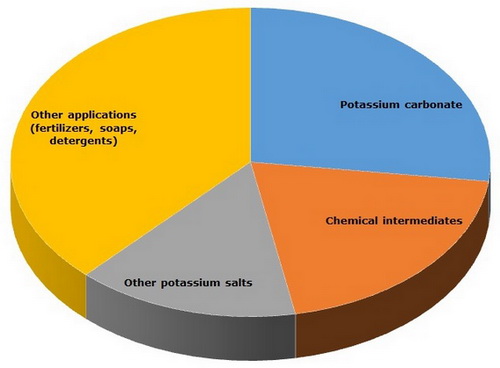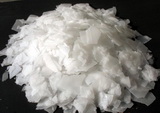Potassium hydroxide (caustic potash or KOH) finds uses in many industrial applications thanks to its hygroscopicity, high reactivity towards acids and other properties. Its major application area is in production of potassium carbonate, which has great commercial value in the market. With the increasing demand from its end-use sectors potassium carbonate is expected to become more and more popular in the near future, which in turn will drive the consumption of potassium hydroxide.
Potassium hydroxide: structure of the global consumption by end-use sector, 2014

Potassium hydroxide is also used as a component in production of liquid fertilizers, soaps, detergents, precursors for many chemicals, etc. Fertilizer use is linked to the rising agricultural production and augmented food demand, which is spurred by the world population increases, disposable income uptake and emerging economies. This seemingly undisputable causal loops seem to provide a strong basis for the potassium hydroxide industry growth and optimism. However, it would be a gross mistake for a potassium hydroxide company working in the present unstable environment to fully rely on such trends. Back in 1960, Theodore Levitt in his paper entitled “Marketing Myopia” warned that there is no such thing as a growth industry and that there are only companies organized and operated to create and capitalize on growth opportunities. He stressed that it is a fallacy and myth to believe that growth can be assured by an expanding and more affluent population. Thus, notwithstanding beneficial consequences of demographics and social well-being, a truly market oriented company operating on the potassium hydroxide market should primarily concentrate its attention on how to produce a flexible and well-balanced range of potassium hydroxide products (either in liquid or solid flaked or pelletized form) covering a broad range of different concentrations and packaging sizes, tailored to customers’ needs. Another major concern today should be about sustainability. Nowadays, this concern includes not only more environmentally friendly technologies, like new membrane electrolysis method for potassium hydroxide production in lieu of outdated mercury cell production (it has to stop by late 2017 due to legislative requirements). Currently, it means the full restructuring of all production and business practices to conform to all pillars of sustainable development, social inclusion and environmental friendliness. Marketing approaches should also evolve, shifting towards relationship marketing and building partnerships. Potassium hydroxide is produced in combination with other chlorine- and potassium-based chemical derivatives, precursors and end-products, which involves a complex network of product relationships, synchronized with existing supply-demand balances, pricing trends, macroeconomic situation and the state of consumption sectors.
More information on the potassium hydroxide market can be found in the comprehensive research study “Potassium Hydroxide 2015 World Market Outlook and Forecast up to 2019”.
